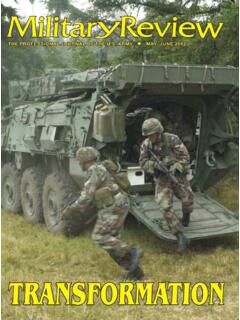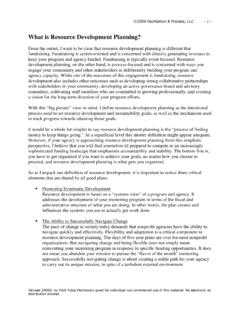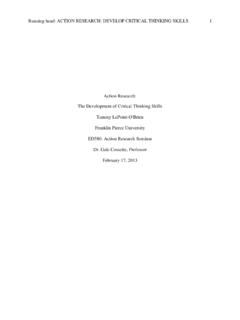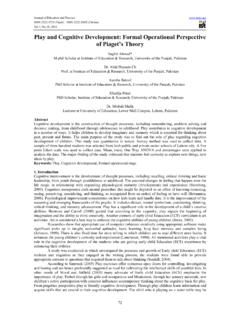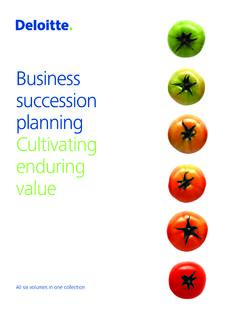Transcription of Improving the Leader Development Experience in Army Units
1 6 May-June 2013 MILITARY REVIEWCOL Douglas C. Crissman recently completed an Army War College Fel-lowship at the University of Texas at Austin. He holds a from the Military Academy and an from the University of Virginia. He commanded a battalion in the 3rd Infantry Division and a brigade combat team in the 1st Cavalry Division. PHOTO: In the early evening twilight of 9 September 2011, soldiers from the 2nd Battalion, 82nd Field Artillery, 3rd Brigade Combat Team, perform sit-ups as part of a circuit obstacle course at Contingency Operating Base Adder in Iraq. Events continued throughout the night and into the next day as aspiring leaders were required to demonstrate their proficiency on a variety of tasks to earn their spurs.
2 ( Army, SPC Sharla Lewis)THE ALL-VOLUNTEER ARMY will draw down by nearly 15 percent over the next four years while the nation concurrently makes difficult strategic choices defining the Army of 2020 and beyond. Faced with fiscal constraints and a challenging and unpredictable global environment, Army leaders seek the optimum balance among personnel, force structure, and readiness. Regardless of the outcome, the country will continue to rely heavily on the Army s professionalism and the talent of its leaders. To maintain this trust and preserve this capability, the Army must continue its efforts to focus on the human dimension by refining and adapting its approach to develop-ing leaders.
3 Recently, the Center for Army Leadership s annual assessment of attitudes and perceptions on Leader Development (CASAL) identified Develops Others as the lowest-rated Leader competency for the fifth year in a over half of Army leaders (59 percent) were regarded as effective at developing others by their The CASAL further revealed that one fourth (22 to 26 percent) of those surveyed indicated their Units placed a low or very low priority on Leader Development Feedback also highlighted varying degrees of Leader and subordinate understanding of what constituted Leader Development activities and programs as well as individual responsibilities as givers and receivers of Leader trends span multiple years and clearly illustrate a deficiency in the perceived effectiveness of Army efforts to raise the next generation in the eyes of its most important audience, today s junior leaders.
4 While the Army has enjoyed a stellar reputation for Leader develop-ment for generations, the decade of war in Iraq and Afghanistan has altered our expectations of what right looks like. The Army must now seize the opportunity to improve consistency and effectiveness of unit-level Leader Colonel Douglas C. Crissman, ArmyThe views expressed in this article are those of the author and do not reflect the official policy or position of the Department of the Army or Department of Defense. Improving the Leader Development Experiencein Army Units7 MILITARY REVIEW May-June 2013 Improving Leader Development Development to deliver capable leaders for the Army of 2020 and beyond.
5 This is best achieved through a concerted effort to Increase awareness and understanding about Leader Development as a process rather than an event. Train and educate battalion and brigade-level commanders on the Army s expectations for them as key Leader developers as well as on fundamental approaches to enhance their success. Expand senior Leader accountability of unit-level Leader Development Development : A Process, not an EventArmy Leader Development is intended to occur across three complementary domains (institutional, operational, and self- Development ) through the lifelong synthesis of education, training, and Reaching a shared understanding of Leader Development is crucial to the subordinate s ability to recognize it when it is happening and to the Leader s ability to identify and leverage opportunities to integrate it with everyday activities.
6 Leader Development is not the outcome of a series of classes or the product of a sequence of assignments, nor is it the job of one person or organization. It is a continuous process intended to achieve incremental and progressive results over The CASAL results suggest the lack of an integrated approach as one reason for lower effectiveness ratings as junior officers consider the various Leader Development activities as isolated events rather than part of an ongoing process of As businesses wrestle with designing effective Leader Development programs, they com-monly cite a patchwork of programs inadequately linked to one another as a persistent obstacle to their In its recently revised and published Army Doctrine Publication (ADP)
7 6-22, Army Leadership, the Army defines Leader Development as recruiting, accessing, developing, assigning, promoting, broadening, and retaining the best lead-ers, while challenging them over time with greater responsibility, authority and accountability. 9 This Leader -driven process goes well beyond monthly professional Development lectures, regular counsel-ing sessions, an ideal combination/progression of assignments, or a two-hour block of instruction in an Army schoolhouse. Annual CASAL results over the past five years indicate subordinates may not always recognize Leader Development opportuni-ties when they are happening, and leaders may be missing or failing to adequately create or leverage key developmental Reading different military and civilian leaders opinions on Leader Development in contemporary literature and reflecting on my own experiences, I recall many instances when Leader Development happened to me.
8 In some cases, I did not realize the true importance of various episodes their long-term impact on my Development as a Leader for months or even years later. For example, I recently came across a book given to me by a battalion commander I had when I was a lieutenant. As I pulled the book off the shelf, a few folded papers dropped to the floor. A handwritten note written more than three years after I had served with this officer explained why he sent me the book: It s important for officers to read widely and be well-read. Nothing is more dangerous for our Army than creating an officer corps of bubbas. It s critical for your generation to be prepared to accept the mantle of senior leadership when you get there and our job is to make you better than we were.
9 The book s title and author are not as important as the act of this concerned senior Leader who built on an existing relationship and made an effort to influence my continued Development . His selfless personal gesture took forethought, vision, and follow-through and demonstrated a desire to be actively engaged with cultivating the next genera-tion to be ready to lead the Army of the future. Similarly, I recall a conversation my brigade commander had with me while I was a young captain commanding one of his companies. He had just observed an after action review (AAR) covering the first three days of a Combat Training Center rotation.
10 While the unit had accomplished a great deal, the AAR brought to the surface several areas for improvement. Noticing that I appeared a bit dejected afterwards, he pulled me aside and quickly recounted all the positive things he heard about our unit during the AAR and identified to me what a great opportunity we now had to work 8 May-June 2013 MILITARY REVIEW on those things we wanted to improve for the rest of the rotation. Now, let s get to work, he said. With a quick slap on the back and a handshake, he was gone, but I will never forget that five-minute conversation and what it meant to me then and how it influenced similar conversations I have had with young leaders since.






